- 9 Lives Arena Review: Building Your Legacy With A 24/7 Companion - January 22, 2023
- Star Atlas Game Overview - December 11, 2022
- Heroes Unchained Game Overview - November 13, 2022
Decentraland is undoubtedly one of the most popular and well-known 3D virtual spaces. More than anything, it is what people think of when they think “metaverse.” As an investment, Decentraland has already proven to be one of the best-performing assets in the crypto space. As a game, the project doesn’t disappoint.
I’ve been a part of this since October 2020 – next month will be the 2nd anniversary of my playing the game, and let me tell you: it’s been a wild ride. From having one of the most incredible virtual experiences available on the market today to an 80% decline, Decentraland has been an absolute game-changer for what the metaverse means and the interactions within this new ecosystem.
Are you excited to get started? Here’s the ultimate Decentraland overview.
Bottom Line Up Front
The whole Decentraland project started in 2015, that’s given the developers seven long years to build their project and turn it into the behemoth of a virtual reality space that we see today. Privacy and decentralized organizations have been the name of the game since 2019. People are looking for an escape from the often monotonous and anxiety-filled world we live in today.
Enter Decentraland: the current leader of the VR marketplace and an awesome, activity-filled, jam-packed-with-adventure game that could get anyone from any age all riled up.
The First of Its Kind (History of Decentraland)
With the current version launched last February 2020, Decentraland, as the name suggests, is a decentralized, three-dimensional virtual reality platform built on the Ethereum blockchain.
If you had a childhood, you’d probably recognize that gameplay resembles other open-world sandboxes such as Roblox and Minecraft. The gameplay highlights what it would be like to live a life in the metaverse.
Their whitepaper highlights, “The project initially began as a proof of concept for allocating ownership of digital real estate to users on a blockchain. “
From here, it just moved and expanded into what it is today. What I especially like about its history is how fitting each stage of the development process’s name is. They are as follows:
The Stone Age
2015 was when Decentraland was launched. It’s also the period that the developers fondly call The Stone Age, similar to the period of prehistory where humans used primitive stone tools. Why? Because there was absolutely nothing on it. At this point, it wasn’t anything more than dots on a screen. It was a 2d grid of pixels with metadata identifying the owner and describing pixel coloration. The best thing you could do during this stage was change the pixel’s color.
Stone Age: A visual representation of pixel estate. Users could mine, transfer, and change the color of pixels they own.
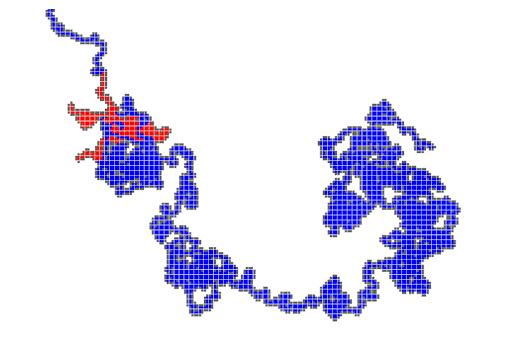
The Bronze Age
The beginning of the Bronze age was marked by the first 3D renderings of the game we all love to see today. The Unity Engine was employed for the game, and according to their announcements, support was also implemented for the HTC Vive. Fun fact: during this time, Decentraland was built on top of a full node implementation of Bitcoin. Landowners could now change the full content description of the land they own instead of just the colors.
It was all starting to come together.
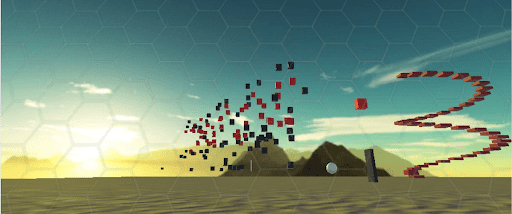
The Iron Age
The Iron Age highlights social experience more than anything else. While explicitly stated nowhere, I believe this is the project’s current stage. The whitepaper clearly states that the goal of this age is to implement peer-to-peer communications and create a scripting system that enables interactive content and fast payment methods for in-world transactions. The Iron Age aims to implement a communication layer for social experiences such as voice chat, postures, and proximity chats.
The Iron Age is the current version of Decentraland.
What is Decentraland?
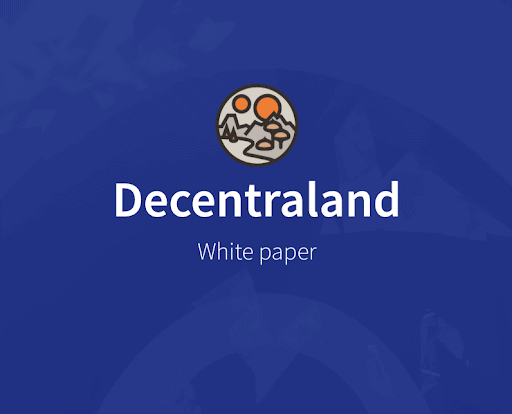
Decentraland is a virtual world where large groups of players can interact with one another in a community-driven space. To have a holistic experience of Decentraland, make sure you purchase some land you could customize to your delight. The flexibility of the language allows for a wide range of use cases like creating objects, handling textures and physics, generating sounds, and even accepting payments. Decentraland has done a great job of allowing various applications to be built on top of the platform.
Large proprietary platforms have allowed hundreds of millions of people to gather, interact, share content and play games. There’s no reason why a decentralized organization such as Decentraland shouldn’t be able to do the same.
Essentially, the game attempts to build a decentralized virtual reality where users can create, experience, and monetize experiences, applications, and content. They do so through land ownership – where any user can purchase 3d land blocks within the community and use it to do absolutely anything. From hosting raging parties to building sanctuaries of peace and tranquility, you can do anything you want with the land you own with the character avatar you’ve created. We’ll get into the gameplay and mechanics in later portions of this overview, but for now, that’s probably all you need to know.
Now, the definitions I’ve given so far have been pretty vague, but hopefully, a well-curated list of use cases for owning land should shed some light on the subject matter:
- Applications
- Content Curation
- Advertising
- Digital Collectibles
- Social Interactions
- Virtual Tourism
- Education
Despite all the interesting things you could do in Decentraland, its most defining facet is the open world that so many could freely explore. Because all land tiles within the game are adjacent, an avatar could galavant and explore the landscape easily. Plus, unlike many other sandbox simulators out there, the land supply is finite. This creates land areas with high traffic and allows for secondary markets to develop around rentals and land borrowing.
Essentially, the economy within the project heavily resembles that of the real world but in a digital setting.
How Does Decentraland Work?
Now this section will go into detail about how the whole Decentraland protocol works. I included this section because it’s essential for potential buyers and players to understand how the system works. Otherwise, how will you know it’s a significant investment? Buying LAND without understanding the system is much like buying a stock without understanding company shares and what it allows you to do.
The whitepaper highlights that Decentraland is comprised of three layers:
- The Consensus Layer – this is where the smart contracts that maintain ledgers of ownership for land parcels are stored. These non-fungible digital assets are unoriginally named LAND, with each parcel having unique (x,y) coordinates, an owner, and a reference to the content description file, with the specifics being found in the Land Content Layer.
- The Land Content Layer – The Land Content Layer is also known as the Content Distribution Layer. The Content Distribution Layer contains the description of the LAND parcel to be rendered: it must include the content files ( how it looks), scripting entry point (positions and behavior of the products), and P2P interactions ( what players could do on the land)
- Real-Time Layer – The Real-Time Layer is hosted by landowners or third parties. This layer renders everything that someone could see on the platform – social experiences, voice hats, and virtual environment interaction are all done here.
Each layer works cohesively with one another to deliver the product. The consensus layer, for example, is where land content is referenced. From here, the Land content layer looks up the smart contract for the description containing all the objects, textures, sounds, and other elements necessary to build the output. Once the content description is acquired, the P2P server is contacted to deliver the output straight to your computer screen.
If that confused you, the whitepaper also includes an illustration of how the Decentraland client provides the experience in a decentralized way.

Why Would You Play Decentraland?
Sorry, that must have been a lot of information to cover. Your mind has probably exploded from all the knowledge that was just shared. That’s fine.
Basically, here’s why you should start playing and investing in Decentraland.
A Centralized Organization Does Not Control Decentraland
Decentraland is run by a Decentralized Autonomous Organization (a DAO). The Decentraland DAO means that users, especially those with governance tokens, have control over the game. Through proposals and a democratic voting process, users decide what happens to their favorite districts.
Take note, however, that the DAO allows players to decide on what happens throughout the whole game. LAND-specific decisions can’t be voted on. What is done to specific parcels of LAND is entirely up to the owner.
If you’re interested in checking out what we mean by “letting the community vote on proposals,” check out Decentraland’s governance platform.
You Have Absolute Control Over Your Assets
We talked about all the different use cases of owning LAND, but here’s the thing: there’s actually no limit to what you can do with your land. You could set up a gallery for all your artwork, a coliseum to hold events and concerts, or a cafe to meet and talk to other people.
Something I love about Decentraland is the fact that there are so many financial establishments within the space, meaning people need to have money to play it. This also means that the economy is growing enough to make an actual living on the platform.
You have absolute control over your assets – what you do is entirely up to you. The flexibility of the scripting language allows for a wide range of use cases, lie object creation, texture loading, and handling physics.
Social Aspect
One of the most extraordinary things about Decentraland is its social aspect – the sheer time and effort that has gone into the game have made it into the social behemoth that it is. With thousands of players on the platform at all times, it’s quite obvious how “social media” could quickly become a “social metaverse” soon enough.
I think the social aspect of the game is what made Decentraland boom. The dozens of companies, businesses, and even celebrities looking to capitalize on this movement are extremely exciting for the community. Hopefully, further raising awareness for the project will add more value.
Bonus: Longevity
It’s no secret that the value of cryptocurrency projects is derived from the community. If no one is playing a game, then there’s absolutely no way it’s going to take off – and there’s absolutely no way that you’ll be able to make a living off of it. No community is no fun, and no fun is no money.
This is where Decentraland shines. Because it was first implemented in 2015, the team behind it has been given enough time to grow and develop the project. Long before any sort of metaverse hype was on the horizon, the DAO behind the game had already been working furiously to build a truly user-owned project that leaves content creation entirely to its users.
Getting Started on Decentraland
I think we’ve talked about the theory and concepts behind Decentraland enough. Let’s talk about how you can get started in the game. I think this is the perfect starting point for anyone looking to get into the metaverse – or even to invest in it to make money. You can read and read all you want, but your takeaways about Decentraland will always be limited due to the absence of time investment.
So, while you read on how to get started playing Decentraland, I suggest you follow along:
Visit the Website
The website can be found at: https://decentraland.org/download/. If you noticed, it doesn’t bring you into the game just yet. You could download Decentraland on your desktop, or you could play it from your browser. As far as I could tell, there’s no difference in either of the options.
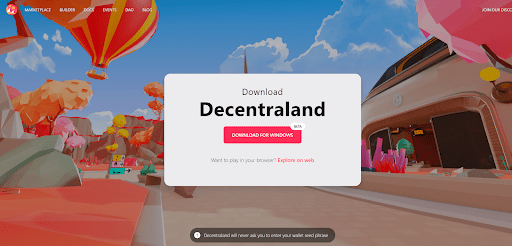
Once you’ve downloaded the desktop app (or clicked explore on the web), you’ll then be led to this next page. This page is when you start getting whisked away to the world of blockchain and cryptocurrencies.
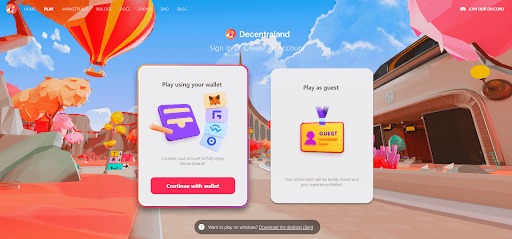
The page asks you to connect to the wallet of your choice (don’t worry, there are a lot of options) or play as a guest. Obviously, playing as a guest will limit your experience as you can’t customize your character the way you want. You also can’t buy land or purchase accessories.
Of course, when you’re playing with your wallet, then all these problems disappear but do note that playing on your browser allows you to use the browser extension version of the wallet you’re using, whereas the desktop version will require you to whip out your phone and sign in through there. That is if you’re using MetaMask.
Making Your Avatar
After logging on, you could then move towards creating your Avatar. There are several attributes for you to choose from and consider; these include body shape, skin tone, shape, and size of the head. Of course, the accessories and clothing you could change at a later time, so don’t worry about that.
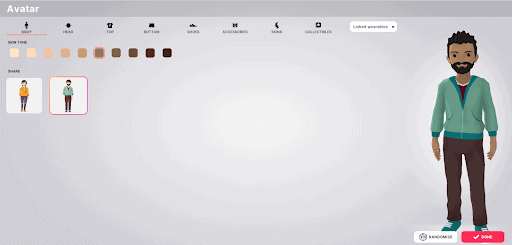
Click “Done” and accept the terms and conditions once you’re ready to start exploring.
You’ll then be teleported to the actual virtual world built inside the Decentraland game platform.
If there’s anything I have to say about the character customization, it’s the lack of options available. A quick glance through the whole thing would make you think it’s a lot – sure. But if you have any experience with Sims, then you’ll quickly realize just how extensive character customization can be.
Explore and Do Activities
Once you’re in, you’ll be taken to a place called Genesis Plaza. For newcomers, you’ll be given a brief tutorial of all the basics you need to know to begin playing the game.

There are tons of activities readily available for you to choose from and get into right away. Classic events have been enjoyed by the players since the dawn of Decentraland, Events are updates of the happenings around the world, and the Crowd is, well, where everyone congregates.

But that’s not really where the fun is at. Jump down the pool in front of you, and you’ll be taken to the rest of Genesis Plaza.
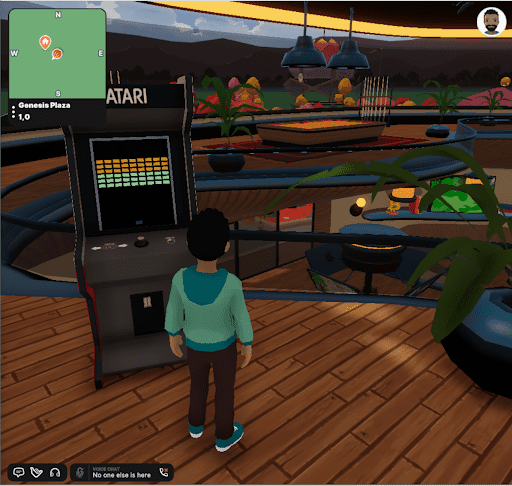
On June 30th of 2020, even before I was playing the game, Genesis Plaza was given an overhaul that allowed players to teleport from one scene to another, whisking players off to some of the most famous scenes in Decentraland, adding external links that will enable players to open a site outside Decentraland, and audio and video streaming that allowed players to listen to podcasts, live music, and see real-world events without having to leave their homes.
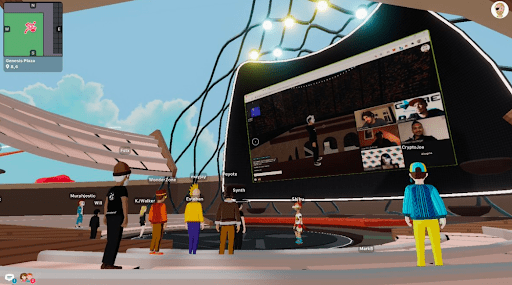
Adding in everything you could do in Decentraland will make this article too long and boring. Instead of reading about it all from little old me, I actually recommend you to get in there and do your thing. Walk around, meet new people, try different activities – understand the community and activities that made Decentraland so popular. Just have fun with it!
Check Out The Marketplace
One last thing you should definitely do after you walk around for a bit is to check out the marketplace. It’s probably the WHOLE reason why you’re interested in Decentraland in the first place, right? The marketplace is where all the financial magic happens. Many people involved in cryptocurrency, especially in blockchain games, join the platform.
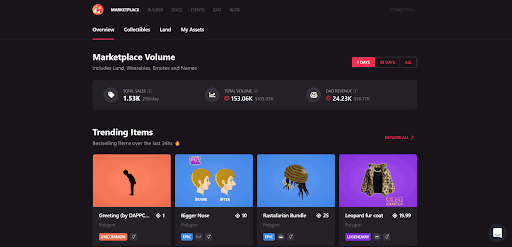
We’ll be diving into a short but detailed buying guide for buying land and accessories in Decentraland later on, so for now, scroll around and see what’s around. I highly recommend you explore Decentraland before investing in it, though, especially if you’re buying NFTs to make money – having a better sense of how the project works will provide you crucial insight into which items will increase or decrease in value.
Buying Land on Decentraland
There are two coins for Decentraland: MANA and LAND. Their explanations and use cases are pretty clear-cut.
MANA is a token used to purchase almost anything within the gaming platform. For collectibles, NFTs, and character accessories, you use MANA. If you want to purchase an in-game accessor or a literal dragon egg, you’ll need to use MANA. Basically, MANA is used for all in-game goods and services.
On the other hand, LAND is a token used to represent the non-fungible digital assets that create beautiful scenery around you. We explored this concept in the “How Does Decentraland Work” section, but now, we get to go into great detail. Each token has the hash code representing the unique coordinates, an owner, and a reference to the content description file.
LAND is also bought by burning MANA to create a new entry in the LAND registry. Of course, given the limited supply, new parcels must be adjective to a non-empty parcel.
LAND’s utility is only as good as its adjacency to other attention hubs, host applications, and identity mechanisms.
Land areas in Decentraland can either fall under Parcels or Estates. Parcels are one-by-one land plots. These are conceptually transferable to mean 16 meters by 16 meters (or 52 feet by 52 feet, depending on where you are in the world). These measurements, while likely not important at the moment, will be essential once Decentraland starts to expand more heavily into VR.
An estate is an association of 2 or more parcels of land directly adjacent to one another. I think it’s hilarious that the developers decided to call a 10,000-foot space an estate because when you think about it, it’s not that big. Regardless, this new feature was added in August of 2018 and was designed to alleviate the stress of having to buy, sell, and shop for individual parcels of land while hoping that no one else scoops up the parcel you want. Basically, it’s what you get if you need bigger space.
You now have a basic understanding of the tokenomics of the game; here’s how to use that knowledge and get started:
Sign Up To Decentraland Marketplace
If you’ve logged into Decentraland before, you’ll likely already have an account that you can use to sign up for the Decentraland Marketplace. Once you’ve signed in, select the land tab and start searching for the parcels available for sale.
Choosing Your Land
Choosing your land is where the buying begins; the Atlas view of the land in the marketplace should show you an overview of all the lands. Hovering over lands should show you the name of the parcel, its coordinates, and the owner of the land. Take note, however, that not all lands are for sale.
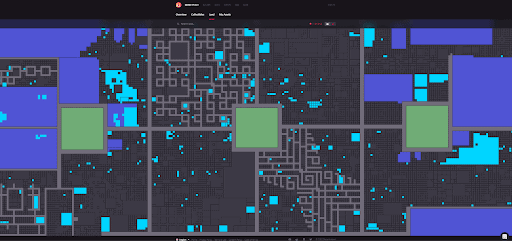
To check for the lands at the sale, you can head on over to the “On Sale” Tab on the top right corner to check out the lands available for sale. They will be highlighted in light blue, as can be seen in the photos above and below.

Purchasing the Land
To purchase the land, you can make an offer or simply buy it at a price it’s currently listed at. To do so, simply click on the land you’re looking to buy and then select “Buy” or “Bid.”

If there are any highlightable spaces nearby, Decentraland will let you know. In the cases of Estates, all coordinates of the individual parcels will be listed down.
Here’s a tip: Before purchasing the land, scope out the area adjacent to it by logging into your account and taking a look around. Honestly, I don’t think people take surroundings into account enough. Buying virtual land is no different from buying real-world real estate.
Confirming Purchase
Have you bought the land? That’s great! Wait for a couple of seconds to confirm the purchase. Depending on the traffic at the moment, it could take up to a couple of seconds before the transaction is completed.
Wearables on Decentraland
Aside from land, users could also mint, purchase, and sell wearables on the platform. Sure, default wearables are already available on the marketplace, but where’s the fun in using that?
Decentraland also supports the creation and use of custom wearables that are also represented by NFTs. That means RARITY!
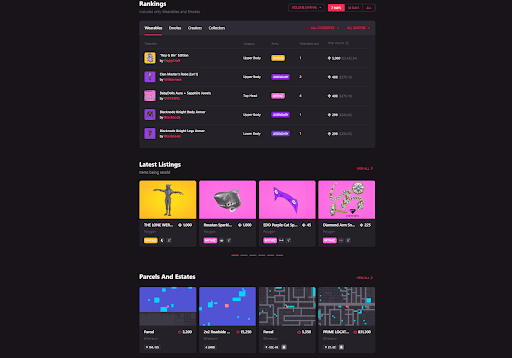
A finite amount of different wearables are minted on the blockchain, similar to LAND – where they develop their value. I think another often overlooked aspect of wearables is how they have little to no gas fees because they are all minted on the Polygon/Matic sidechain, as the Decentraland documents so gladly point out.
If you want a full list of the wearables you can create and use, you should definitely check out the “Creating Wearables” portion of the Decentraland documents.
Similar to land, wearables can be divided into single, individual items or collections.
This is where it gets kind of confusing.
NFT versions represent the items. This means that when you buy an item, you don’t actually get the item; you get the NFT representation of it. Decentraland makes it a point to highlight that there are a limited number of NFTs of that same item; this helps keep the rarity value of the item at an understandable level.
To that end, only the NFT representation of the item could be bought or sold.
Items are also just a single piece of a greater collection.
Collections were created to help content creators organize and manage their individual items. You could have a hat and a shirt added to the “Management collection” and then make NFT representations of the hat and shirt to trade and sell. Creating a collection requires you to submit it to the Wearables Editor for uploading before use.
Here are some Wearable reference models that you could use to guide yourself in getting started.
If making money was your goal in the game, you should probably stick to buying and selling land. However, the capability to provide a wide range of accessories to be bought and sold within a community is great for creators. As a creator, you would traditionally have had to find a manufacturer, set up a digital store, and market your clothing through many platforms before seeing ONE sale. Through NFTs, you could do all of this through one platform: Decentraland. You could argue that physical and digital products aren’t the same, but in my eyes, a buyer is a buyer and a sale is a sale – a sale on Decentraland isn’t worth more than a sale in the real world.
FAQs
Question: Is Decentraland A Good Investment?
Answer: If history is your only consideration, then, in my opinion, the answer is yes. But it’s never that simple. There are so many facets that come into play when it comes to investments that there’s just no one answer to this question: it all boils down to the type of investor you are and your tolerance for risk.
If you’re a creator, I definitely think you should look into Decentraland as a potential means of income. The profits produced from the use of your land parcel are retained by the owner, after all. Other systems will probably take a cut – Decentraland doesn’t.
Question: Can Decentraland Make More Land?
Answer: Decentraland has a total number of 90,000 parcels. Users can, of course, develop, buy, and trade the land as they see fit. This level of scarcity is actually one of the drivers of the value of LAND in the project.
Question: What Is The Point Of Decentraland?
Answer: Decentraland is a user-owners, Ethereum-based virtual world. Its point is to create a space where users can play, explore, and interact with other people through land environments that they’ve built. On the land parcels, users can create games, build applications, offer gambling services, and generate dynamic 3D scenes that hold real-world value.
Conclusion
No matter your experience in the investment world, Decentraland will continue to be a risky investment. The metaspace is growing, yes, especially after Facebook changed its name to MetaVerse. It’s slowly becoming the reality of the world. The metaverse is and will be the next big thing.
Decentraland is positioned to be the leader in the VR wave expected to come next year – so why not start earlier and get your account up and running today? Who knows, maybe you’ll make a couple million through LAND and MANA trading along the way.
Looking for more interesting readings? Check out:

